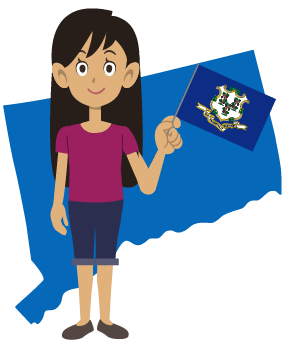On January 9, 1788, Connecticut became the fifth of the original colonies to join the United States, and we’ve prepared you this homeschool unit study supplement just in time for Connecticut’s anniversary. Whether you live in Connecticut or are simply interested in the “Constitution State,” we’ve collected information about its history and geography for you to use as part of your homeschool state unit study.
You’ll also find educational destinations in CT, perfect for planning field trips with your homeschoolers. Once you’ve studied all the interesting facts about Connecticut, put your homeschooler to the test with fun learning games and other activities about the Nutmeg state. Combine this with Time4Learning’s full series of United States unit study supplements to teach your homeschooler the rich history of our country.
Are you ready to find out what important reference book was first published in Connecticut? Want to know how many miles of river wind through the state? Then let’s get started learning! You can also download our list of PreK-12 interactive activities that align with your study of interesting facts about Connecticut.
Connecticut Fast Facts
| Became a Colony | 1636 |
|---|---|
| Became a State | January 9, 1788 |
| Order it Joined the Union | 5th state |
| State Capital | Hartford |
| State Abbreviation | CT |
| Border States |
|
| State Flag |  |
| State Song | |
| State Nicknames |
|
| Notable People from Connecticut |
|
Historical Facts About Connecticut
The word Connecticut is derived from a word that the Mohegan tribe had for the long, winding river that flowed through the area that is now Connecticut: “Quinnehtukqut.” For thousands of years, the Mohegan were the only inhabitants of the area until English Puritans created a settlement there. The first European explorer to discover the Connecticut area was Dutchman Adriaen Block in 1614. While under Dutch rule, the area was part of the Dutch colony called “New Netherland.” In 1636, Connecticut officially became a colony. Chief trade and enterprise in the Connecticut Colony included whaling, fishing, shipbuilding, fur trading, timber production, and maple syrup.
Because of its structural government document of 1638/1639 called “The Fundamental Orders,” Connecticut got its nickname as “The Constitution State” for having the first formal state constitution in the Western world. Connecticut was the fifth colony to become a state on January 9, 1788.
At one point, there were two different capitals: Hartford and New Haven. Hartford eventually became the single state capital in 1875.
In 1784, Connecticut begins the gradual abolition of slavery, which became fully outlawed in 1848.
Many abolitionists lived in CT during the anti-slavery movement of the 1800’s, including Harriet Beecher Stowe and John Brown.
Connecticut has no county government. There is state-level government and the city/town-level government. New Haven-born George W. Bush was elected 43rd President of the U.S. in the 2000 election.
To increase your child’s love for online learning, they can study the timeline which includes highlights of important dates in the history of the Constitution State as well as interesting facts about Connecticut.
1614
The first European explorer, Adriaen Block, arrived.
1633
The first English settlers arrived.
1636
The Connecticut Colony was established by Thomas Hooker.
1639
John Haynes becomes the first governor of the state.
1701
Yale College was established.
1764
The Connecticut Courant, the oldest newspaper in the U.S., was launched.
1776
Four delegates from the Second Continental Congress signed the Declaration of Independence on behalf of the state.
1781
The Battle of Groton Heights during the American Revolutionary War took place.
1788
Connecticut is the fifth colony to become a state.
1789
Oliver Ellsworth and William Samuel Johnson become the first senators of the state.
1806
Noah Webster publishes the first American dictionary.
1848
Connecticut abolished slavery.
1875
Hartford becomes the capital.
1877
The world’s first telephone exchange opened in New Haven.
1946
President George W. Bush was born in New Haven
1974
Ella Grasso becomes the first female governor of the state.
Geographical Facts About Connecticut
While there are plenty of Connecticut facts for children that highlight the history of the state, you’ll want to make sure to cover important facts about Connecticut’s geography, too. Exploring a map of the state will help a lot, then download our printable Connecticut map and mark it up with your child! Here are just some of the things you may want to explore and mark on your map.
- Connecticut is the third smallest state (after Rhode Island and Delaware)
- The Connecticut River, the Thames River, and the Long Island Sound have been formative in the state’s long maritime history.
- The state has a variety of geographical features including rolling mountains, river valleys, and beaches.
- There are over 5,800 miles of river in the state of CT.
- All three rock types are found in Connecticut: sedimentary, metamorphic, and igneous.
- If you are standing in Stamford, CT, you can travel north, south, east, or west, and the next state you will hit is New York.
- Mt. Frissell, the highest point in Connecticut, is found in the northwestern corner of the state.
- Geologists believe that Lake Hitchcock in CT formed over 15,000 years ago when a glacial ice melt dammed up part of the Connecticut River.
- Ivy League University Yale, is located on the south part of this small state, in the city of New Haven, 40 miles south of the state’s capital Hartford!
Connecticut State Map
Download our FREE Connecticut state map printable. Use it as a coloring page or use it to plot the state’s geographical features.
Educational Places of Interest in Connecticut
One of the best ways to energize any state unit study is by adding hands-on activities. Do you live in Connecticut? Or perhaps you will be traveling to the state in the near future? Homeschooling families will discover plenty of interesting things in Connecticut that are perfect for field trips. Here are some ideas for day trips where you can experience Connecticut’s history and geography for yourself.
- Aldrich Contemporary Art Museum (Ridgefield) — in addition to the chance to experience many forms of modern art, the museum offers educational programs specifically for families, including take-home projects.
- Connecticut Children’s Museum (New Haven) — a giant learning playground for students. Homeschoolers will learn about everything from music to logic and mathematics to the natural world in the museum’s eight thematic rooms.
- Harriet Beecher Stowe Center (Hartford) — visit Stowe’s historic home to learn about what inspired her to write Uncle Tom’s Cabin and to find out why her story is still relevant in today’s world.
- Mystic Aquarium and Institute for Exploration (Mystic) — a place to interact with a wide variety of marine life including beluga whales, sea lions, and African penguins. The aquarium offers both formal and informal educational programs.
- New Pond Farm Education Center (West Redding) — instead of a single field trip, this destination is designed for long-term membership. Members have year-round access to 102 acres of this small working farm with learning opportunities on everything from Native Americans to astronomy.
For additional field trip options in Connecticut, visit A2Z Homeschooling’s Connecticut Field Trips with Kids page.
Connecticut Freebies and Deals for Homeschoolers
- Connecticut Science Center (Hartford) — homeschoolers receive discounted admission to the science center with proper homeschool identification. They can also get a 15% off discount on yearly memberships.
- Connecticut Supreme Court (Hartford)— students of all ages will appreciate the chance to see what their state’s courtroom looks like and discover why it is the only court of its kind in CT. Groups can tour for free Monday through Friday by calling to schedule their visit.
- John J. McCarthy Observatory (New Milford) — explore the calendar on their website to find out when the next free educational program is offered for families.
- The Museum of Connecticut History (Hartford) — when you’re ready to learn even more important facts about Connecticut , this free field trip is the perfect addition to your state unit study.
- The Yale Peabody Museum of Natural History (New Haven) — the dinosaur lovers in your house will be delighted with this excursion. Plus, on Thursday afternoons, visitors can enter on a “pay as you wish” basis.












